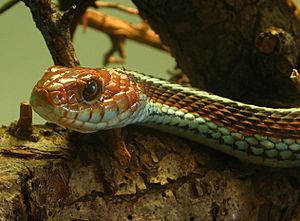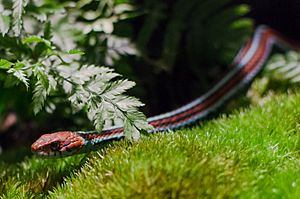San Francisco garter snake facts for kids
Quick facts for kids San Francisco garter snake |
|
|---|---|
 |
|
| Conservation status | |
| Scientific classification |
|
| Kingdom: | Animalia |
| Phylum: | Chordata |
| Class: | Reptilia |
| Order: | Squamata |
| Suborder: | Serpentes |
| Family: | Colubridae |
| Genus: | Thamnophis |
| Species: | |
| Subspecies: |
T. s. tetrataenia
|
| Trinomial name | |
| Thamnophis sirtalis tetrataenia (Cope, 1875)
|
|
| Synonyms | |
|
|
The San Francisco garter snake (Thamnophis sirtalis tetrataenia) is a beautiful, colorful subspecies of the common garter snake. It has been an endangered subspecies since 1967. This snake lives only in San Mateo County and the northern part of Santa Cruz County in California.
Scientists believe there are only about 1,000 to 2,000 adult snakes left. However, these snakes are very shy and hard to find. They love wet and marshy areas. Because they are so good at hiding, it's tough to know exactly how many there are or where they all live.
Contents
Where the San Francisco Garter Snake Lives
The San Francisco garter snake lives in different wet areas on the San Francisco Peninsula. You can find them from the northern part of San Mateo County down to Año Nuevo Point and Waddell Creek in Santa Cruz County.
It's hard to count these snakes because they are very secretive. Much of their home is on private land that hasn't been explored. These snakes are very shy and will quickly hide in water or under cover if they feel disturbed. The U.S. Fish and Wildlife Service says that many places where these snakes used to live are now losing their populations. This is because of new buildings and the filling in of wetlands over the last 60 years. Still, in some areas, if you know where to look and understand their behavior, you might find them.
What the San Francisco Garter Snake Looks Like
Adult San Francisco garter snakes can grow to be about 18 to 55 inches (46 to 140 cm) long. They have scales that are blue-green. These scales are outlined by stripes of black, red (sometimes orange), and more blue-green. Their head is red and only a little wider than their neck. They have large eyes, which helps them see well during the day when they are most active.
Garter snakes are mostly harmless to people. Their bites can kill their prey, but for humans, a bite usually only causes a mild irritation. They have a little bit of venom in their saliva, but they don't have fangs.
San Francisco Garter Snake Habitat
The San Francisco garter snake prefers to live near ponds with lots of plants. They also like open hillsides where they can warm up in the sun, find food, and hide in rodent burrows. They can also live in temporary ponds and other seasonal freshwater areas.
These snakes avoid salty marsh areas. This is because their favorite food, the California red-legged frog, cannot live in salty water. They like to hide in plants like cattails, bulrushes, and spike rushes. They often bask in the sun between streams, ponds, and grasslands. If they feel danger, they quickly escape into dense plants or water. Sometimes, they even use floating mats of algae or rushes for cover.
What the San Francisco Garter Snake Eats
San Francisco garter snakes spend a lot of time hunting in watery places. Adult snakes mainly eat California red-legged frogs. These frogs are also a threatened species. They might also eat young American bullfrogs. However, adult bullfrogs are too big for them to eat. In fact, adult bullfrogs sometimes eat young garter snakes, which can be a problem for the garter snake population.
Baby and young San Francisco garter snakes mostly eat Pacific treefrogs. If there aren't enough young Pacific treefrogs, the baby garter snakes might not survive. Interestingly, San Francisco garter snakes are one of the few animals that can eat the poisonous California newt without getting sick or dying.
San Francisco Garter Snake and Other Snakes
The San Francisco garter snake shares its home with two other types of garter snakes: the coastal garter snake (a kind of western terrestrial garter snake) and the Santa Cruz garter snake (a kind of aquatic garter snake). All three of these snakes eat similar foods. However, they each have slightly different favorites:
- The San Francisco garter snake mostly eats small frogs.
- The coastal garter snake mainly eats slugs.
- The Santa Cruz garter snake prefers tiny fish and young amphibians.
Protecting the San Francisco Garter Snake
Many of the problems that made the San Francisco garter snake endangered in 1967 are still happening today. These include losing their habitat because of farms, businesses, and new buildings. Also, some people try to collect these snakes as pets, which is illegal because they are endangered. It's very important to protect these special snakes so they can survive.
Images for kids
See also
 In Spanish: Serpiente de liga de San Francisco para niños
In Spanish: Serpiente de liga de San Francisco para niños




